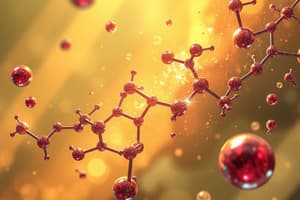Podcast
Questions and Answers
Which amino acid residue has a pKa value closest to physiological pH (~7.4), making it a crucial player in enzymatic catalysis?
Which amino acid residue has a pKa value closest to physiological pH (~7.4), making it a crucial player in enzymatic catalysis?
- Lysine
- Aspartic acid
- Histidine (correct)
- Tyrosine
The pKa of the alpha-amino group of an amino acid is significantly lower than the pKa of its alpha-carboxyl group.
The pKa of the alpha-amino group of an amino acid is significantly lower than the pKa of its alpha-carboxyl group.
False (B)
What is the approximate pKa of the guanidino group in arginine?
What is the approximate pKa of the guanidino group in arginine?
~12
The pKa of the side chain of cysteine (Cys-SH) falls in the range of _ to 11 in proteins.
The pKa of the side chain of cysteine (Cys-SH) falls in the range of _ to 11 in proteins.
Match the amino acid residue with its approximate pKa range in proteins:
Match the amino acid residue with its approximate pKa range in proteins:
Which of the following ionizable groups has the lowest pKa value?
Which of the following ionizable groups has the lowest pKa value?
The pKa values of ionizing groups are identical in model compounds and within the protein environment.
The pKa values of ionizing groups are identical in model compounds and within the protein environment.
What amino acid possesses an imidazole group?
What amino acid possesses an imidazole group?
The side chain of _ has a pKa around 10.4 in model compounds.
The side chain of _ has a pKa around 10.4 in model compounds.
Match each amino acid with its corresponding functional group:
Match each amino acid with its corresponding functional group:
How does the microenvironment influence the pKa of an ionizable group within a protein?
How does the microenvironment influence the pKa of an ionizable group within a protein?
Arginine is typically negatively charged at physiological pH.
Arginine is typically negatively charged at physiological pH.
What is the approximate pKa of the alpha-carboxyl group in model compounds of amino acids?
What is the approximate pKa of the alpha-carboxyl group in model compounds of amino acids?
The pKa of the hydroxyl group in _ can range from 9 to 12 within proteins.
The pKa of the hydroxyl group in _ can range from 9 to 12 within proteins.
Match each amino acid with its approximate pKa in a small peptide:
Match each amino acid with its approximate pKa in a small peptide:
Which amino acid contains a thiol group, which can form disulfide bonds?
Which amino acid contains a thiol group, which can form disulfide bonds?
The pKa of phosphates is consistent within a protein.
The pKa of phosphates is consistent within a protein.
What range of pKa values is typical for histidine residues in proteins?
What range of pKa values is typical for histidine residues in proteins?
In model compounds, the pKa of the alpha-amino group of an amino acid is approximately _ .
In model compounds, the pKa of the alpha-amino group of an amino acid is approximately _ .
Match each amino acid with its listed pKa:
Match each amino acid with its listed pKa:
Which amino acid residue is commonly targeted by ubiquitination?
Which amino acid residue is commonly targeted by ubiquitination?
Phosphorylation involves the addition of a phosphate group to a protein, typically from an ATP molecule.
Phosphorylation involves the addition of a phosphate group to a protein, typically from an ATP molecule.
What molecule donates the acetyl group during acetylation?
What molecule donates the acetyl group during acetylation?
The process of adding a myristoyl group to a protein is known as __________.
The process of adding a myristoyl group to a protein is known as __________.
Match the following covalent modifications with the amino acid residues they commonly target:
Match the following covalent modifications with the amino acid residues they commonly target:
Which enzyme is responsible for activating ubiquitin in the ubiquitination process?
Which enzyme is responsible for activating ubiquitin in the ubiquitination process?
Methylation always leads to the activation of the target enzyme.
Methylation always leads to the activation of the target enzyme.
What is the precursor molecule that provides the adenosine monophosphate (AMP) group in adenylylation reactions?
What is the precursor molecule that provides the adenosine monophosphate (AMP) group in adenylylation reactions?
Which of the following modifications involves the transfer of a fatty acid?
Which of the following modifications involves the transfer of a fatty acid?
Covalent modifications are always irreversible.
Covalent modifications are always irreversible.
What is the amino acid that is modified during methylation?
What is the amino acid that is modified during methylation?
Which molecule is released during the acetylation of a protein?
Which molecule is released during the acetylation of a protein?
ADP-ribosylation always leads to enzyme inactivation.
ADP-ribosylation always leads to enzyme inactivation.
Which of the following amino acids can be targeted by phosphorylation?
Which of the following amino acids can be targeted by phosphorylation?
Adenylylation involves the addition of an AMP moiety to a tyrosine residue.
Adenylylation involves the addition of an AMP moiety to a tyrosine residue.
Flashcards
pKa of Amino Acid α-COOH (model compounds)
pKa of Amino Acid α-COOH (model compounds)
The pKa of the amino acid alpha-carboxyl group in model compounds (small peptides) is around 3.6.
pKa of Asp (CO2H)
pKa of Asp (CO2H)
The pKa of Aspartic acid (CO2H) is around 4.0 in model compounds (small peptides), while the usual range in proteins is 2-5.5.
pKa of Glu (CO2H)
pKa of Glu (CO2H)
The pKa of Glutamic acid (CO2H) is around 4.5 in model compounds (small peptides), while the usual range in proteins is 2-5.5.
pKa of His (imidazole)
pKa of His (imidazole)
Signup and view all the flashcards
pKa of Amino Acid α-NH2
pKa of Amino Acid α-NH2
Signup and view all the flashcards
pKa of Lys (ε-NH2)
pKa of Lys (ε-NH2)
Signup and view all the flashcards
pKa of Arg (guanidine)
pKa of Arg (guanidine)
Signup and view all the flashcards
pKa of Tyr (OH)
pKa of Tyr (OH)
Signup and view all the flashcards
pKa of Cys (SH)
pKa of Cys (SH)
Signup and view all the flashcards
Ubiquitination
Ubiquitination
Signup and view all the flashcards
Phosphorylation
Phosphorylation
Signup and view all the flashcards
ADP-ribosylation
ADP-ribosylation
Signup and view all the flashcards
Adenylylation
Adenylylation
Signup and view all the flashcards
Methylation
Methylation
Signup and view all the flashcards
Acetylation
Acetylation
Signup and view all the flashcards
Myristoylation
Myristoylation
Signup and view all the flashcards
Study Notes
- Some enzymes are regulated by reversible covalent modification
Types of Reversible Covalent Modification:
-
Ubiquitination (Lys):
- Ubiquitin activation occurs with the help of HS-E2.
- Activated ubiquitin forms.
- Activated ubiquitin and HS-E2 interact with an enzyme.
-
Phosphorylation (Tyr, Ser, Thr, His):
- ATP converts to ADP.
- An enzyme gets phosphorylated.
-
Adenylylation (Tyr):
- ATP converts to PPi.
- An enzyme undergoes adenylylation, incorporating an adenosine group.
-
Acetylation (Lys, α-amino (amino terminus)):
- Acetyl-CoA converts to HS-CoA.
- An enzyme gets acetylated.
-
Myristoylation (α-amino (amino terminus)):
- Myristoyl-CoA converts to HS-CoA.
- An enzyme gets myristoylated.
-
ADP-ribosylation (Arg, Gln, Cys, diphthamide—a modified His):
- NAD converts to nicotinamide.
- An enzyme undergoes ADP-ribosylation.
-
Methylation (Glu):
- S-adenosylmethionine converts to S-adenosylhomocysteine.
- An enzyme gets methylated.
pKa Values of Ionizing Groups
- Model compounds like small peptides and proteins have different pKa values for their ionizable groups.
Amino Acid pKa Values
- Amino acid α-COOH has a pKa of 3.6 in model compounds and a usual range of 2-5.5 in proteins.
- Asp (CO2H) has a pKa of 4.0 in model compounds and a usual range of 2-5.5 in proteins.
- Glu (CO2H) has a pKa of 4.5 in model compounds and a usual range of 2-5.5 in proteins.
- His (imidazole) has a pKa of 6.4 in model compounds and a usual range of 5-8 in proteins.
- Amino acid α-NH2 has a pKa of 7.8 in model compounds and a usual value of ~8 in proteins.
- Lys (ε-NH2) has a pKa of 10.4 in model compounds and a general value of ~10 in proteins.
- Arg (guanidine) has a pKa of ~12 in model compounds. There is no usual range provided for proteins.
- Tyr (OH) has a pKa of 9.7 in model compounds and a usual range of 9-12 in proteins.
- Cys (SH) has a pKa of 9.1 in model compounds and a usual range of 8-11 in proteins.
- Phosphates have pKas of 1.3 and 6.5 in model compounds. There is no usual range provided for proteins.
Studying That Suits You
Use AI to generate personalized quizzes and flashcards to suit your learning preferences.



